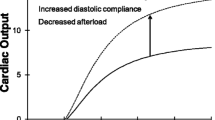Abstract
The effects of ventricular geometry, muscle mass, muscle elasticity and external pressures on the pressure-volume and muscle stiffness-stress relations have been quantitated on the basis of a theoretical model. Data taken from patients before and after interventions with nitroprusside and angiotensin were applied to the model in order to explain the possible causes for the marked shifts in the pressure-volume relations.
The results indicate that (a) ventricular geometry does not markedly alter the pressure-volume and stiffness-stress relations unless there is a drastic change from a spherical shape to an ellipsoidal shape orvice versa, (b) increases in muscle mass and muscle elasticity of the order of 30% result in significant alterations in the P-V relations but are not the cause for the parallel shifts unless accompanied by substantial external pressures, (c) the parallel shifts in the pressure-volume relations can be accounted for entirely by the presence of external pressures without changes in muscle mass or muscle elasticity. Thus manipulation of right ventricular pressures or pericardial pressures by drug interventions may be useful in the treatment of left heart disease and the presence of such pressures must be considered in the analysis of ventricular function curves.
Similar content being viewed by others
Literature
Alderman, E. L. and S. A. Glantz. 1976. “Acute Hemodynamic Interventions Shift the Diastolic Pressure-Volume Curve in Man.”Circulation,54, 662–671.
Barry, W. H., J. Z. Brooker, E. L. Alderman and D. C. Harrison. 1974. “Changes in Diastolic Stiffness and Tone of the Left Ventricle During Angina Pectoria.”Circulation,44, 255–263.
Bing, O. H. L., J. F. Keefe, M. J. Wolk, L. J. Finkelstein and H. J. Levine. 1971. “Tension Prolongation During Recovery from Hypoxia.”J. Clin. Invest.,50, 660–666.
Brodie, B. R., W. Grossman, T. Mann and L. P. McLaurin. 1977. “Effects of Sodium Nitroprusside on Left Ventricular Diastolic Pressure-Volume Relations.”J. Clin. Invest.,59, 59–67.
Dwyer, E. M. 1970. “Left Ventricular Pressure-Volume Alterations and Regional Disorders of Contraction During Myocardial Ischemia Induced by Atrial Pacing.”Circulation,42, 1111–1122.
Flessas, A. P., G. P. Connelly, S. Handa, C. R. Tilney, C. K. Kloster, R. H. Rimmer, J. F. Keefe, M. D. Klein, T. J. Ryan. 1976. “Effects of Isometric Exercise on the End Diastolic Pressures, Volumes and Functions of the Left Ventricle in Man.”Circulation,53, 839–847.
Gaasch, W. H., H. J. Levine, M. A. Quinones, J. K. Alexander. 1976. “Left Ventricular Compliance: Mechanisms and Clinical Implications.”Am. J. Cardiol.,38, 645–655.
Grossman, W., L. P. McLaurin. 1976. “Diastolic Properties of the Left Ventricle.”Ann. Intern. Med.,84, 316–326.
Hefner, L. L. and T. E. Bowen, Jr. 1967. “Elastic Components of Cat Papillary Muscle.”Am. J. Physiol.,213, 1221–1227.
Holt, J. P. 1970. “The Normal Pericardium.”Am. J. Cardiol.,26, 455–465.
Mirsky, I. 1969. “Left Ventricular Stresses in the Intact Human Heart.”Biophys. J.,9, 189–208.
—, W. W. Parmley. 1973. “Assessment of Passive Elastic Stiffness for Isolated Heart Muscle and the Intact Heart.”Circ. Res.,33, 233–243.
—, P. F. Cohn, J. A. Levine, R. Gorlin, M. V. Herman, T. H. Kreulen and E. H. Sonnenblick. 1974. “Assessment of Left Ventricular Stiffness in Primary Myocardial Disease and Coronary Artery Disease.”Circulation,50, 128–136.
— 1976a. “Assessment of Passive Elastic Stiffness of Cardiac Muscle: Mathematical Concepts, Physiological and Clinical Considerations, Directions of Future Research.”Prog. Cardiovasc. Dis.,18, 277–308.
Mirsky, I., R. F. Janz, B. R. Kubert, B. Korecky and G. C. Taichman, 1976b. “Passive Elastic Wall Stiffness of the Left Ventricle: A Comparison Between Linear Theory and Large Deformation Theory.”Bull. Math. Biol.,38, 239–251.
Mirsky, I. 1977. “Ventricular Pressure-Volume Indices Change with End Diastolic Pressure.”Circ. Res.,41, 135–137.
O’Brien, K. P., L. M. Higgs, D. L. Glancy and S. E. Epstein. 1969. “Hemodynamic Accompaniments of Angina: A Comparison During Angina Induced by Exercise and by Atrial Pacing.”Circulation,39, 735–741.
Parker, J. O., S. DiGiorgi and R. W. West. 1966. “A Hemodynamic Study of Acute Coronary Insufficiency Precipitated by Exercise: With Observations on the Effect of Nitroglycerin.”Am. J. Cardiol.,17, 470–478.
Parmley, W. W., E. H. Sonnenblick. 1967. “Series Elasticity in Heart Muscle: Its Relation to Contractile Element Velocity and Proposed Muscle Models.”Circ. Res.,20, 112–120.
Rabkin, S. W. and P. H. Hsu. 1975. “Mathematical and Mechanical Modeling of Stress-Strain Relationship of Pericardium.”Am. J. Physiol.,229, 896–900.
Sonnenblick, E. H. 1962a. “Implications of Muscle Mechanics in the Heart.”Fedn Proc.,21, 975–990.
— 1962b. “Force-Velocity Relations in Mammalian Heart Muscle.”Am. J. Physiol.,202, 931–939.
Taubert, K., J. T. Willerson, W. Shapiro and G. H. Templeton. 1977. “Contraction and Resting Stiffness of Isolated Cardiac Muscle: Effects of Inotropic Agents.”Am. J. Physiol.,1, H275, 282–290.
Templeton, G. H., R. R. Ecker and J. H. Mitchell. 1972. “Left Ventricular Stiffness During Diastole and Systole: the Influence of Changes in Volume and Inotropic State.”Cardiovasc. Res.,6, 95–100.
Tyberg, J. V., L. A. Yeatman, Jr., W. W. Parmley, C. W. Urschel and E. H. Sonnenblick. 1970. “Effects of Hypoxia on Mechanics of Cardiac Contraction.”Am. J. Physiol.,218, 1780–1788.
Weiner, L., E. M. Dwyer and J. W. Cox. 1968. “Left Ventricular Hemodynamics in Exercise-Induced Angina Pectoris.”Circulation,38, 240–248.
Author information
Authors and Affiliations
Rights and permissions
About this article
Cite this article
Mirsky, I. Effects of external pressures on the pressure-volume relation of the left ventricle. Bltn Mathcal Biology 40, 465–482 (1978). https://doi.org/10.1007/BF02460772
Received:
Revised:
Issue Date:
DOI: https://doi.org/10.1007/BF02460772



